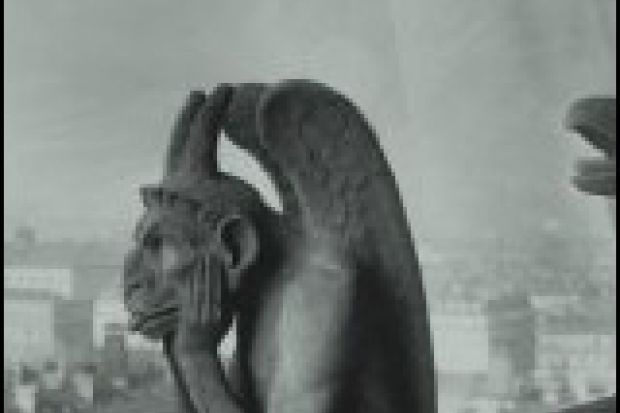Michael Camille was professor of art history at the University of Chicago: this extraordinary, comprehensively illustrated and cogently argued book is his last opus, completed just before his death in 2002.
The cathedral-church of Notre Dame, Paris, is familiar to many people, but what stands today is really a 19th-century creation (including the tall and elegant fleche over the crossing). A daguerreotype image of the west front, taken by Vincent Chevalier circa 1839, shows a rather sad blancmange of a building, with badly eroded stonework, blocked windows, niches denuded of statuary, and a central main portal with an arch instead of a lintel. This last work of vandalism, involving the removal of several medieval sculptures, was carried out in 1771 under Jacques-Germain Soufflot (known best for the great neo-Classical church of Sainte-Geneviève, converted into the Panthéon in the 1790s) to permit the royal canopy of Louis XV's processions to enter and leave the building. During the most violent period of the Revolution (when Taliban-like destroyers gave themselves freedom to wreck anything of which they disapproved), all signs of féodalité (feudalism) were ruthlessly excised, and that meant hacking away almost all the jamb figures of the facade as well as removing 28 colossal statues of the Gallery of Kings in two orgies of destruction starting in 1793.
When the building became a Temple of Reason further damage was done but, curiously, it was the fact that, in 1789, church property was expropriated by the State that eventually saved Notre Dame: the State was obliged to intervene from the time of the July Monarchy (1830-48) to carry out major restoration works on the Métropole (as it was called) because it was falling to bits.
One of the most vociferous voices demanding such a programme was that of Victor Marie Hugo (whose Quasimodo, the deformed bell-ringer in his 1831 work, Notre Dame de Paris, was almost gargoyle-like). A competition for the building's rescue was announced in 1842 and won in 1843 by Jean-Baptiste-Antoine Lassus and Eugene-Emmanuel Viollet-le-Duc. In a report of 1845 they argued for the restitution of gargoyles, together with flying buttresses, roofs, terraces and much else.
Those powerful, inventive sculptures that were installed under Viollet-le-Duc and his colleagues were new creations that evoked an imaginary past: the "chimeras" were designed by Viollet, many of whose wonderful drawings were interpreted by the sculptor Victor-Joseph Pyanet rather than by Adolphe-Victor Geoffroy-Dechaume (who was in charge of the sculpture studio), and include Le Stryge, that strange, devilish "vampire" with protruding tongue, horned head, wings and chin resting on his hands as he looks out over Paris from his high vantage-point.
Camille links these fearsome creations with all sorts of mid-19th-century Parisian obsessions, such as visits to the morgue for entertainment, racial stereotypes (particularly anti-Semitic ones), sexually transmitted diseases (some of which are graphically represented in all their ghoulish horror in the projecting gargoyles), the supernatural, conditions of mental and psychological abnormalities and much else, all backed by copious notes, a formidable bibliography, and a serviceable index.
The illustrations alone are amazing (many are very early photographs), and the whole monumental, provocative, finished volume is a tribute to scholarship as well as to the protagonists of one of the most spectacular works of controversial restoration ever undertaken. The book investigates the monstrous and its influence on the modern (as, of course, the project was at the time), as well as providing thoughtful asides on 19th-century interpretations of the meanings given to medievalism and to a revived medieval artefact.
One quibble: Baedeker is spelled thus; not Baedecker.
The Gargoyles of Notre Dame: Medievalism and the Monsters of Modernity
By Michael Camille
University of Chicago Press 464pp, £34.00
ISBN 9780226092454
Published 19 May 2009
Register to continue
Why register?
- Registration is free and only takes a moment
- Once registered, you can read 3 articles a month
- Sign up for our newsletter
Subscribe
Or subscribe for unlimited access to:
- Unlimited access to news, views, insights & reviews
- Digital editions
- Digital access to THE’s university and college rankings analysis
Already registered or a current subscriber? Login
